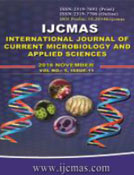


 National Academy of Agricultural Sciences (NAAS)
National Academy of Agricultural Sciences (NAAS)

|
PRINT ISSN : 2319-7692
Online ISSN : 2319-7706 Issues : 12 per year Publisher : Excellent Publishers Email : editorijcmas@gmail.com / submit@ijcmas.com Editor-in-chief: Dr.M.Prakash Index Copernicus ICV 2018: 95.39 NAAS RATING 2020: 5.38 |
1National Program of Post-Doctorate (PNPD) –CAPES, Catholic University of Pernambuco, 50050-590, Recife, Pernambuco, Brazil;
2Department of Biology, Federal Rural University of Pernambuco, 52.171-900
Recife, Pernambuco, Brazil;
3Master in Development of Environmental Processes , Catholic University of Pernambuco, 50.050-900 Recife, Pernambuco, Brazil.
4Nucleus of Research in Environmental Sciences and Biotechnology, Catholic University of Pernambuco, 50050-590, Recife, Pernambuco, BrazilThe biosurfactants are compounds of microbial origin that exhibit surfactant property, low toxicity and high biodegradability. In this study was to evaluate the production of surfactant by Mucor polymorphosphorus, isolated from Caatinga soil from Brazil, using agro-industrial residues. The experiments were monitored by Central Composite Rotational Design (CCRD) using as variable response the reduction of the surface tension. The factors selected for study were soybean waste oil and corn steep liquor as substrates. The spore suspension containing 107sporangiospores/mL were inoculated in Erlenmeyer flasks containing the alternative medium according factorial design; The flasks were grown during 96 hours, at 28°C and 150 rpm. All factors studied were important within the ranges investigated. The empirical forecast model developed regarding effective nutritional factors was adequate for explain 84.79% of the variation observed on biosurfactant production. Maximal reduction in surface tension of 33.2 mN.m-1 with final pH 6.5 was obtained under the optimal conditions of corn steep liquor 4.61% and soybean oil after frying 7.5%. These results demonstrated that the factorial design is adequate for identifying the optimal conditions for biosurfactant production by fungi.
 |
 |
 |
 |
 |